Next time when you say ‘The sky’s the limit’, make sure that you’re not at Tai Po Waterfront Park, because you may find that the sky there will deflate your pep talk. Sky Lines, one of the five installation artworks made by students of the CUHK School of Architecture, creates a touchable sky with a dense shower of suspended white and blue threads.
This year, the Leisure and Cultural Services Department invited the School of Architecture to design and install site-specific works in Tai Po Waterfront Park for the annual ArtAlive@Park project. Named 'Sensing Horizons: Five Excursions into Intimate Immensity', the CUHK project aims to explore the dialogue between the horizon and human senses with five installation works in the park.
Architecture as Public Art
Many in Hong Kong may think that architecture is about construction, in diametrical opposition to art as pure creativity. One may ask: ‘Why should architecture students be involved in designing public art?’ Prof. Chung Wang-leung Thomas at the School of Architecture is one of the curators of the project. He explains, ‘Architecture as both an academic discipline and profession is actually concerned with the “art of designing well” of the built environment, that is, to realize building designs that both look good and work well. So in training our students, the emphasis is on the creative fusion of technics and aesthetics. In other words, you could say architects should aspire to design buildings that are works of public art serving the community.’
When asked how works by architecture students differ from those by fine art students, Professor Chung answers, ‘Perhaps typically, one might associate works of fine art more with the pure expression of the artist, ranging from refined aesthetics, existential poetics to deliberate provocations in the tradition of Avant-Gardism, while in contrast, works of architects tend to reinforce established order, be it spatial or physical structure, materiality and texture, as well as involving users and the social dimension. However, in this day and age, the distinction is much more blurred.’
As the CUHK project is part of the 20th Anniversary of the School of Architecture, the school tried to engage as wide a range of students as possible. The five teams comprised second- and third-year undergraduates, year-out students, as well as postgraduates of master’s programmes, and alumni. Professor Chung, together with Prof. Hui Mei-kei Maggie and Prof. Poon Ho-lun Allen, were curators of the project, guiding the students through the design process and organizing the exhibition in the park. He says, ‘We treated the entire project like it was taking place inside a design studio, in a serious but fun way, with a collaborative format and two-way dialogue between teachers and students rather than one-way instruction. Our collaborating artist Ivy Ma also gave us lots of early inspiration.’ And the entire preparation period took over five months. It was a big test of everyone’s interest, effort and commitment.
Beyond the Horizon
Inspired by kite flying, a popular activity at the park, creators of Floating Petals also wanted to harness the wind. Their artwork makes the wind ‘visible’ through the wind-driven movements of its artificial ‘petals’ planted in water. With pendulums under them, these red translucent acrylic panels on steel stems move in the direction of the wind.
Lovers of Lewis Carroll’s classic Alice’s Adventures in Wonderland will surely find Looking for Alice adorable. The artwork features four cone-like objects on a lawn. These brown cones are of different sizes. Lam Ka-ling Chloe, one of its creators, says, ‘From a certain angle, the four cones are seemingly of the same size because of perspectival illusion. But as visitors get closer, they’ll discover the actual size of each cone.’ The biggest cone can accommodate a visitor and make him or her feel like Alice going down the rabbit hole.
Visitors of the park can get a kaleidoscopic view of the location by looking at Lenscape, a room-sized viewing device equipped with 49 cuboids. Each cuboid is installed with a magnifying plastic sheet. All together, they give visitors a unique visual experience.
Tai Po is a popular spot for cycling. If you want to enjoy biking without worrying about falling over, try Ridethebench, an artwork combining parts of park benches, barrier railings, bicycles. Ho Tsz-wai Jimmy, one of the creators of Ridethebench, says, ‘We dismantled bikes and put them together again to make a bench.’ They encourage visitors to physically interact with the artwork by pedaling this ‘stationary bike’.
Conception of all five works started with pushing the idea of the horizon beyond the boundary between earth and sky, to include boundaries both real and imaginary, interior and exterior, far away and close up. Although dealing with the same theme, each work strongly reflects the distinctive character of the individual student group.
After the opening of the exhibition, the teams have had to deal with the maintenance of the artworks, and give weekly guided tours to the public to explain their installations. ‘As a testimony to the quality of our artworks, all of them withstood the recent typhoon signal no. 10 in the open air without any damage, surviving the typhoon battering much better than other structures in the park!’ says Professor Chung proudly.
The exhibition runs until 30 September. 


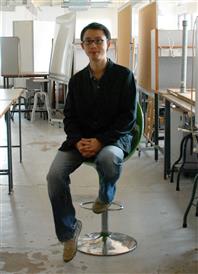
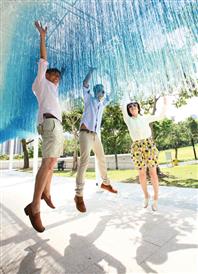
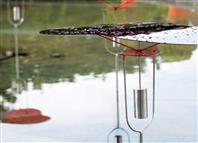
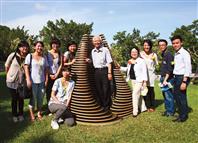
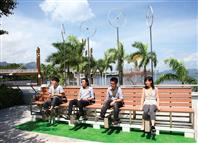
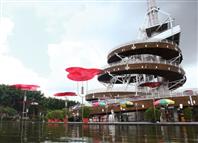
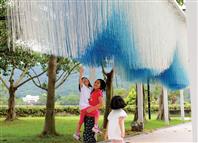
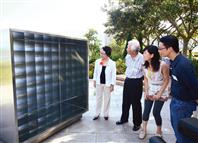
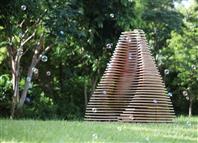
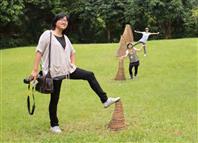
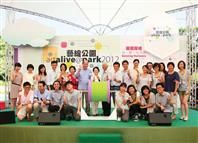
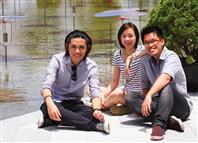































































































































































Social Bookmarks